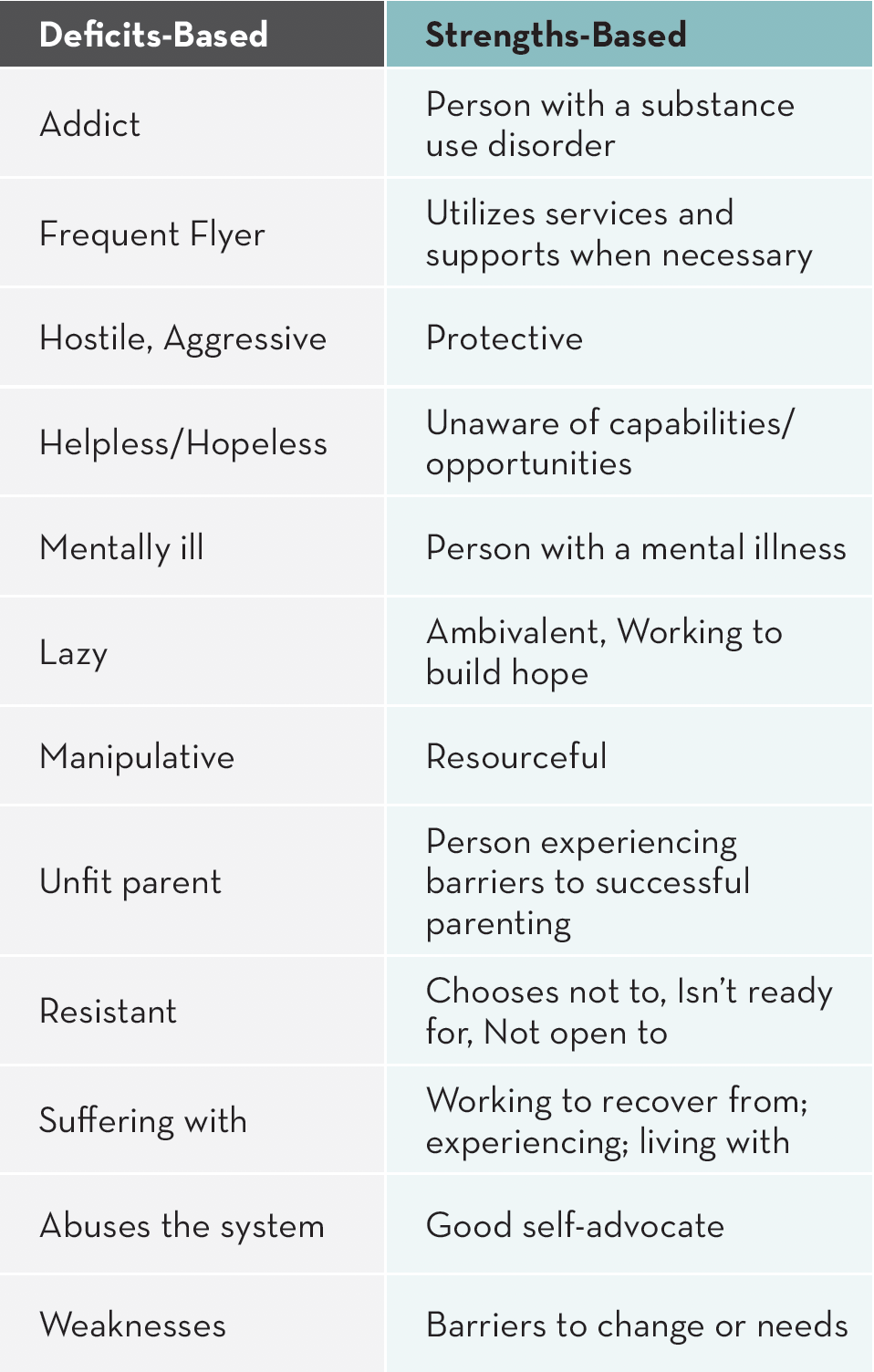Person-Centered Language
What is Person-Centered Language?
Person-centered language is language that puts people first. People are so much more than their substance use disorder, mental illness, or disability. Using person-centered language is about respecting the dignity, worth, unique qualities and strengths of every individual. A person’s identity and self-image are closely linked to the words used to describe them.
Utilizing person-centered language emphasizes the person first rather than the illness. A person-centered approach shifts the sole focus toward their unique recovery and individual strengths. It puts the focus on getting to know the person, not just the illness.
Conversely, when a practitioner uses deficits-based language filtered through a diagnostic label, they may become negatively biased and depersonalize the individual they are working with. Practitioners sometimes use casual labels when describing individuals, such as ‘junkie’ for an individual with a substance use history or ‘cutter’ for an individual that engages in self-harm. Typically, practitioners are not intending to demean individual but using this language can become an accepted part of the agency’s culture. These narrow and negative labels are stigmatizing and can result in discriminatory and ineffective care.
Below are some examples of deficits-based and strengths-based terms used in treatment settings. Note that person-centered language is constructed with the use of post-modified nouns (e.g. person with a substance use disorder) literally putting the person first in the sentence structure.

Why Person-Centered Language?
Anyone, even helping professionals, may use stigmatizing and deficits-based language unintentionally and thus create an additional barrier toward recovery for the individual. Everyone must make a conscious effort to re-frame situations through person-centered language.
The following examples* highlight the importance of utilizing person-centered language when conceptualizing an individual and describing the individual to colleagues. One example is written from a more traditional perspective and the other written from a person-centered, strengths-based perspective. Be sure to read the note that follows the descriptions.
(This individual prefers the pronouns ‘they’ and ‘their.’)
Drew: Drew is an addict that began abusing drugs and alcohol around 12 years old. Drew was manipulative and a real “party animal.” The addict hit “rock bottom” and even cut their wrists. The “cutter” was out of control and placed in rehab at age 13. Drew’s mother was unfit and so the addict emancipated themselves at age 14 from her and abused the system.
Barry: Barry is a person that has a substance use disorder. Barry is a resourceful and talented actor that began their career at 11 months old. Their mother took them to many parties and Barry was exposed to substances at a young age. After a couple of years, Barry couldn’t successfully cope with their substance use disorder and needed treatment, which they received. Barry’s mother was experiencing barriers to successful parenting. Barry decided to emancipate themselves at age 14, as that decision seemed to be self-advocating for their best choice for recovery.
Recovery focuses on a person’s capacity for change, which means emphasizing an individual’s strengths and not just their symptoms.
Strengths-based roles support the recovery process, while negative language emphasizes stigma and promotes isolation.
An important question to consider, “Is naming the disorder pertinent to this conversation with this individual or colleague?” If it is not significant to treatment, then consider leaving it out of the interaction.
*Note: The two descriptions above are of the same individual working toward recovery.
Put yourself in the practitioner role and consider how the different descriptions might influence your perception of the individual and your subsequent interactions and treatment plan. Similarly, what are the implications of this for how the individual comes to think about him/her/their self and their recovery?
The Center for Practice Transformation is sponsored by funds from the Minnesota Department of Human Services Adult Mental Health Division and Alcohol and Drug Abuse Division.